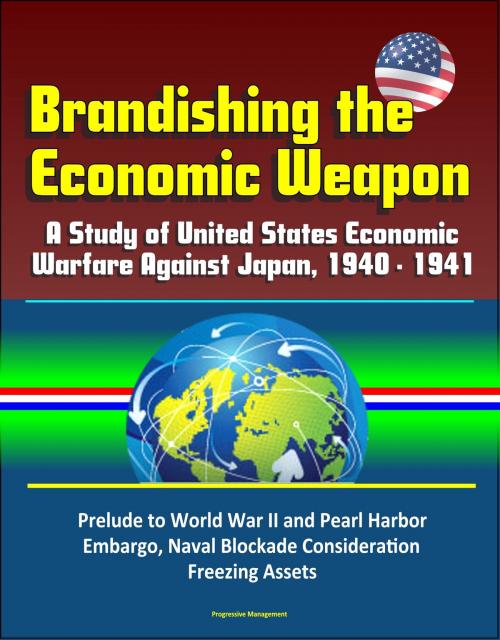Brandishing the Economic Weapon: A Study of United States Economic Warfare Against Japan, 1940 - 1941, Prelude to World War II and Pearl Harbor, Embargo, Naval Blockade Consideration, Freezing Assets
Nonfiction, History, Military, Strategy, World War II| Author: | Progressive Management | ISBN: | 9781370583973 |
| Publisher: | Progressive Management | Publication: | July 30, 2016 |
| Imprint: | Smashwords Edition | Language: | English |
| Author: | Progressive Management |
| ISBN: | 9781370583973 |
| Publisher: | Progressive Management |
| Publication: | July 30, 2016 |
| Imprint: | Smashwords Edition |
| Language: | English |
Professionally converted for accurate flowing-text e-book format reproduction, this study examines the role of American economic warfare against Japan prior to the outbreak of World War II. Beginning with Japan's invasion of China in 1937 and continuing with the outbreak of World War II, the Roosevelt administration and the majority of Americans could not ignore the plight of friendly nations nor overlook foreign threats to American interests. Even as China, Britain and France struggled for survival, however, Americans supported only measures short of war, wishing to aid friendly nations while avoiding involvement in hostilities. The Roosevelt administration responded to these conflicting goals by pursuing policies many critics have described as confusing, devious and ineffective.
Historians examining United States Far Eastern policy prior to Pearl Harbor have emphasized the nation's devotion to the open door in Asia and resistance to Japanese expansion. They have also stressed American and Japanese political and military decisions leading to the Japanese attack on Pearl Harbor. Most scholarly efforts have inadequately explored the Roosevelt administration's program of economic warfare against Japan during 1940 and 1941 and how it influenced the direction of American - Japanese relations during those crucial years.
From President Jefferson's commercial embargoes during the Napoleonic wars to the Confederacy's effort to embargo cotton during the Civil War, and, most recently, when President Carter embargoed wheat to the Soviet Union in 1980, the American experience in economic warfare has been unsuccessful. The Prussian soldier-philosopher, Carl Von Clausewitz once wrote war is a continuation of politics through other means. If this is true, as it is widely believed to be, then economic sanctions are more than a form of diplomatic pressure: They are a form of warfare.
What, then, was the Roosevelt administration endeavoring to accomplish when it employed sanctions against Japan? Was it trying to deter Japan from attacking British, Dutch, aid American territories? Was it trying to encourage Japanese leaders to negotiate? Was it trying to undermine Japan's military and economy? Or was it seeking to use symbolic gestures to mobilize Americans to support more interventionist foreign policies? The answers to these questions are linked to Roosevelt's styles of leadership and administration, rivalries among his lieutenants, conflicts among government agencies, public opinion, and interplay between diplomatic and military policies. These were the crucial forces influencing the Roosevelt administration's handling of the Japanese threat.
Professionally converted for accurate flowing-text e-book format reproduction, this study examines the role of American economic warfare against Japan prior to the outbreak of World War II. Beginning with Japan's invasion of China in 1937 and continuing with the outbreak of World War II, the Roosevelt administration and the majority of Americans could not ignore the plight of friendly nations nor overlook foreign threats to American interests. Even as China, Britain and France struggled for survival, however, Americans supported only measures short of war, wishing to aid friendly nations while avoiding involvement in hostilities. The Roosevelt administration responded to these conflicting goals by pursuing policies many critics have described as confusing, devious and ineffective.
Historians examining United States Far Eastern policy prior to Pearl Harbor have emphasized the nation's devotion to the open door in Asia and resistance to Japanese expansion. They have also stressed American and Japanese political and military decisions leading to the Japanese attack on Pearl Harbor. Most scholarly efforts have inadequately explored the Roosevelt administration's program of economic warfare against Japan during 1940 and 1941 and how it influenced the direction of American - Japanese relations during those crucial years.
From President Jefferson's commercial embargoes during the Napoleonic wars to the Confederacy's effort to embargo cotton during the Civil War, and, most recently, when President Carter embargoed wheat to the Soviet Union in 1980, the American experience in economic warfare has been unsuccessful. The Prussian soldier-philosopher, Carl Von Clausewitz once wrote war is a continuation of politics through other means. If this is true, as it is widely believed to be, then economic sanctions are more than a form of diplomatic pressure: They are a form of warfare.
What, then, was the Roosevelt administration endeavoring to accomplish when it employed sanctions against Japan? Was it trying to deter Japan from attacking British, Dutch, aid American territories? Was it trying to encourage Japanese leaders to negotiate? Was it trying to undermine Japan's military and economy? Or was it seeking to use symbolic gestures to mobilize Americans to support more interventionist foreign policies? The answers to these questions are linked to Roosevelt's styles of leadership and administration, rivalries among his lieutenants, conflicts among government agencies, public opinion, and interplay between diplomatic and military policies. These were the crucial forces influencing the Roosevelt administration's handling of the Japanese threat.















